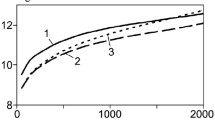Abstract
The optimum operation modes of the Raman lidar and the differential absorption and scattering lidar for the hydrogen sulfide molecules sensing in the atmosphere at the low permissible concentration level have been studied and the error estimation of the hydrogen sulfide molecules concentration measurement in the atmosphere by the Raman lidar and the differential absorption and scattering lidar has been executed. The computer simulation of the two types of such a lidar equations has been fulfilled for this purpose. The measurement relative accuracy for the range of the studied molecules concentration of 1011–1014 cm–3 at the 3.83 μ laser radiation wavelength and the ranging distances from 10 do1000 m lies in the range of 20–26% for the differential absorption and scattering lidar.
Similar content being viewed by others
References
Privalov, V.E., Fotiadi, A.E., and Shemanin, V.G., Lasers and Atmospheric Environmental Monitoring., St. Petersburg: Lan, 2013.
Privalov, V.E. and Shemanin, V.G., Lidars for control and measurements, Proc. SPIE, 1998, vol. 3345, pp. 6–10.
Merkurev, S.V., Privalov, V.E., and Shemanin, V.G., Raman lidar for remote sensing of sulfur-containing hydrocarbons in the atmosphere, Tech. Phys. Lett., 2000, vol. 26, no. 1, pp. 23–25.
Privalov, V.E. and Shemanin, V.G., Accounting of the lasing line width in Raman lidar equation, J. Opt. Technol., 2015, vol. 82, no. 9, pp. 11–15.
Privalov, V.E. and Shemanin, V.G., Measurement of the concentration of hydrocarbon molecules by Raman light lidar, Meas. Tech., 2016, vol. 59, no. 9, pp. 933–938.
Measures, R., Laser Remote Sensing, Moscow: Mir, 1987.
Donchenko, V.A., Kabanov, M.V., Kaul, B.V., and Samokhvalov, I.V., Atmospheric Electro Optics, Tomsk: NTL Publ., 2010, pp. 178–181.
Privalov, V.E. and Shemanin, V.G., A lidar equation with allowance for the finite width of the lasing line, Bull. Russ. Acad. Sci.: Phys., 2015, vol. 79, no. 2, pp. 149–159.
Privalov, V.E. and Shemanin, V.G., Parameters of differential absorption lidar for molecular iodine sensing in atmosphere, J. Opt. Technol., 1999, vol. 66, no. 2, pp. 40–42.
Zuev, V.V., Kataev, M.Yu., Makogon, M.M., and Micel, A.A., Lidar method of differential absorption. Modern status of studies, Atmos. Oceanic Opt., 1995, vol. 8, no. 8, pp. 1136–1164.
Author information
Authors and Affiliations
Corresponding author
About this article
Cite this article
Privalov, V.E., Shemanin, V.G. Hydrogen Sulfide Molecules Lidar Sensing in the Atmosphere. Opt. Mem. Neural Networks 27, 120–131 (2018). https://doi.org/10.3103/S1060992X18020091
Received:
Accepted:
Published:
Issue Date:
DOI: https://doi.org/10.3103/S1060992X18020091




